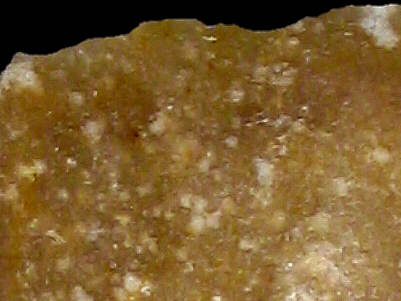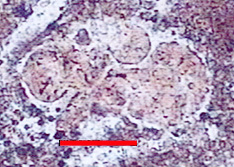
Foto: Jehanne Féblot-Augustins, 2005.
- La Roche (Leyssard)
- Le Devin
Sampled sites:
| Material name: | CN1b |
| Synonyms: | Silex Crétacé supérieur Nord - Sénonien (Campanien) |
| Material (geologic): | Campanian (Senonian, Late Cretaceous) flint |

Foto: Jehanne Féblot-Augustins, 2005. |
Sampled sites:
|
| Quite similar to CN1a, with the following differences: | |
| Pattern: | The specks are strung together, forming parallel streaks. |
| Appearance: | Centre is homogeneous, while outer parts are poorly silicified. |
| Structure: | Arrangement of grains distinctly more fluidal, numerous recrystallized zones. |
| Grains: | 20 to 25 %, mean size 100 to 300 µ, greater frequency of fuzzy 1000 µ elements (sponge conjunctive tissue ?), high degree of micritization, more recrystallization haloes. |
| Grain composition: | Fewer sponge spicules, generally thin-walled ; fewer foraminifera, and only globose species (Globigerinelloides sp., Hedbergella planispira, Archaeoglobigerina sp.). |
 Globotruncanidae (Archaeoglobigerina sp.) in CN1b flint |
||
|
Photo: A. Arnaud Vanneau, (Laboratoire de Géodynamique des Chaînes Alpines, Grenoble) Determination: M. Caron, Université de Fribourg. |
| Further information: | Click here for the original French description (opens in a new window), or here for more information on the attributes used in the description (use your browser's "BACK"-button to return here). |
| Citing: | Information on citing this page can be found here. |
| Locality: | Leyssard / La Roche, France, Ain department |
| Synonyms: | Sampling site Bugey 53 after Féblot-Augustins |
| Geographical description: | The material was collected on a steep hillside adjacent to the road that connects the village of Leyssard with the main D 979. |
| Geographical co-ordinates: |
east/x 842.35 north/y 2133.7 (Lambert zone II, NTF)
This corresponds with |
| Co-ordinate precision: |
The coordinates given were taken from a large-scale map, and are within approx. 50 metres of the actual spot. The latitude/longitude coordinates are a direct transformation of these data on WGS84 and are accurate to the same level, so don't be deceived by the apparently high precision to the second. The location can be found on the 1:25 000 topographical map sheet 3229 W of the French Institut Géographique National. |
| Geology: |
According to the geological map, the parent rock belongs to unit C6 (Late Cretaceous, Senonian). Map of all sampled localities of Late Cretaceous flint in the Bugey (PDF, 54 KB, opens in new window). |
| Type of source: | Primary. |
| Other types of flint: | All flint in this locality is of the CN1b variety. |
thumb.jpg) Foto: Jehanne Féblot-Augustins, 2005 |
thumb.jpg) Foto: Jehanne Féblot-Augustins, 2005 |
| Locality: | Leyssard / Le Devin, France, Ain department |
| Synonyms: | Sampling site Bugey 56 after Féblot-Augustins |
| Geographical description: | The sampling site is located just above some hairpin-bends in the narrow road which connects the village of Leyssard with the main road D 979. Nearby there also is a path which goes from the mentioned hairpin-bends in the direction of Sonthonnax-le-Vignoble to the west. |
| Geographical co-ordinates: |
east/x 842.37 north/y 2134 (Lambert zone II, NTF)
This corresponds roughly with |
| Co-ordinate precision: |
As usual, the French Lambert-values were taken off a large-scale topographical map and the geographical coordinates were calculated directly by transforming those values on WGS84. The precision of both are within 50 metres. The location can be found on the 1:25 000 topographical map sheet 3229 W of the French Institut Géographique National. |
| Geology: |
According to the geological map, the substrate consists of clays-with-flints (Rs), which are the residues of dissolved/decalcified Late Cretaceous formations (C6). Map of all sampled localities of Late Cretaceous flint in the Bugey (PDF, 54 KB, opens in new window). |
| Type of source: | Secondary. |
| Other types of flint: | The residual loams on this location contain also CN1a and CN2b flint. |
thumb.jpg) Foto: Jehanne Féblot-Augustins, 2005 |
| Last modified on: November 15, 2005 |
Contents primarily by: Jehanne Féblot-Augustins |
Comments to: |